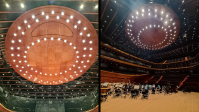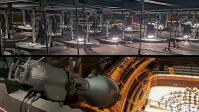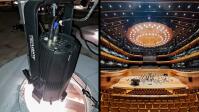PROLIGHTS equip the National Polish Radio Symphony Orchestra with green technologies
May 12, 2023
The shift towards sustainability in the theater industry is becoming increasingly decisive and tangible. The National Polish Radio Symphony Orchestra sets a righteous example by replacing traditional halogen/tungsten fixtures with new PROLIGHTS' technologies: EclPar TU e EclProfile FWTU.
The National Polish Radio Symphony Orchestra in Katowice is one of the leading Polish symphony orchestras, as well as a versatile cultural institution. The concert hall, with acoustics designed by Nagata Acoustics, has a reputation for being one of the best concert halls in the world in terms of acoustics. Proof of this is the fact that NOSPR is one of only two European institutions to have been admitted to the international organization ECHO, which brings together 21 of Europe's most prestigious concert halls.
Thanks to the support of Show Design, Prolights' distributor in Poland, NOSPR has decided to replace the old incandescent halogen house lights with PROLIGHTS EclPar TU for the lighting of the foyer and the ceiling above the stage. The excellent quality of the light, smooth dimming, the possibility of replacing the optics, the silent operation and the high energy efficiency are the characteristics that have determined the choice of this model for such an important location.
In addition, the PROLIGHTS EclProfile FWTU were installed in the theater to illuminate the front-stage, with a CCT of 3200K. The optics with a narrow angle of 5 º were selected to ensure adequate intensity despite the long thorw distance.
"The customer was looking for a profile luminarie with high-power and high-quality light." said the Show Design team, "due to the long distance from the light source to the stage front, the device also had to have a sufficiently high output, as well as the right available optics".
Two solutions that have undoubtedly contributed to energy saving and to the infrastructural simplification of the wiring, decreasing the dimmer channels inside the theater, improving the management of the lighting system and making maintenance easier. The National Radio Symphony Orchestra's choice demonstrates that the theater industry can approach sustainability by adopting innovative technologies that contribute to improving the venue infrastructure and minimizing environmental impact.
Subscribe to our Newsletter
©2024 Music & Lights S.r.l. - VAT No. IT02057590594




















